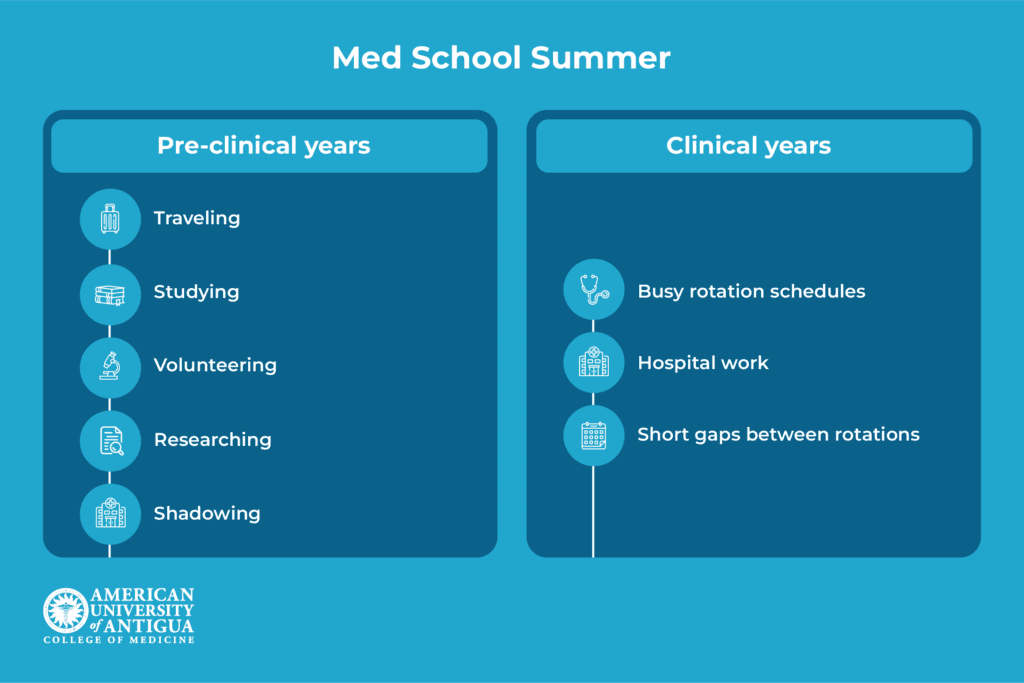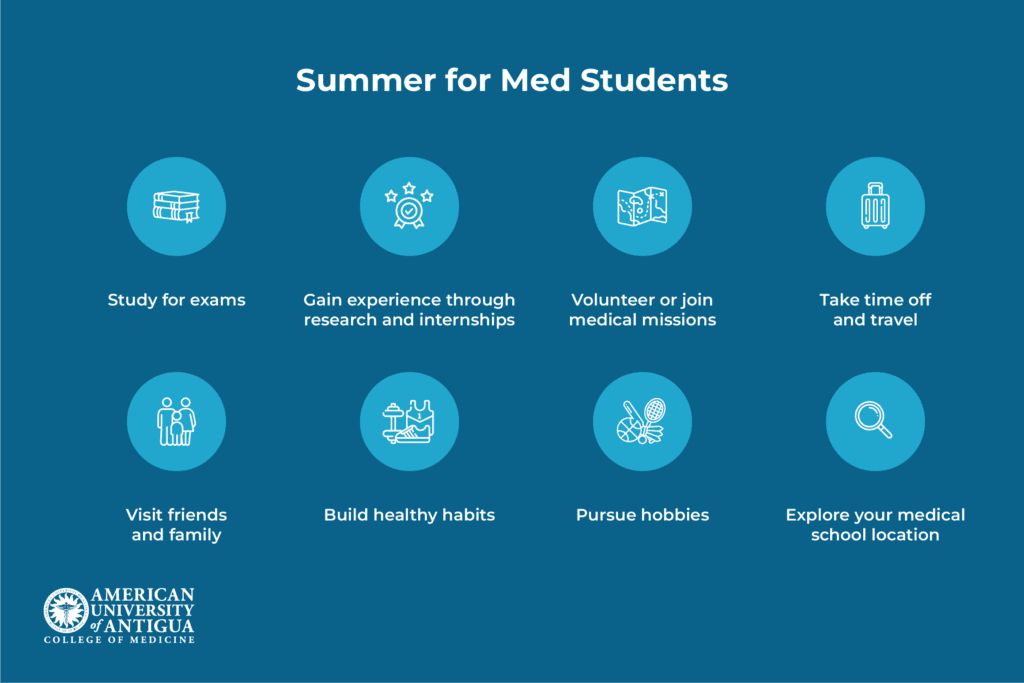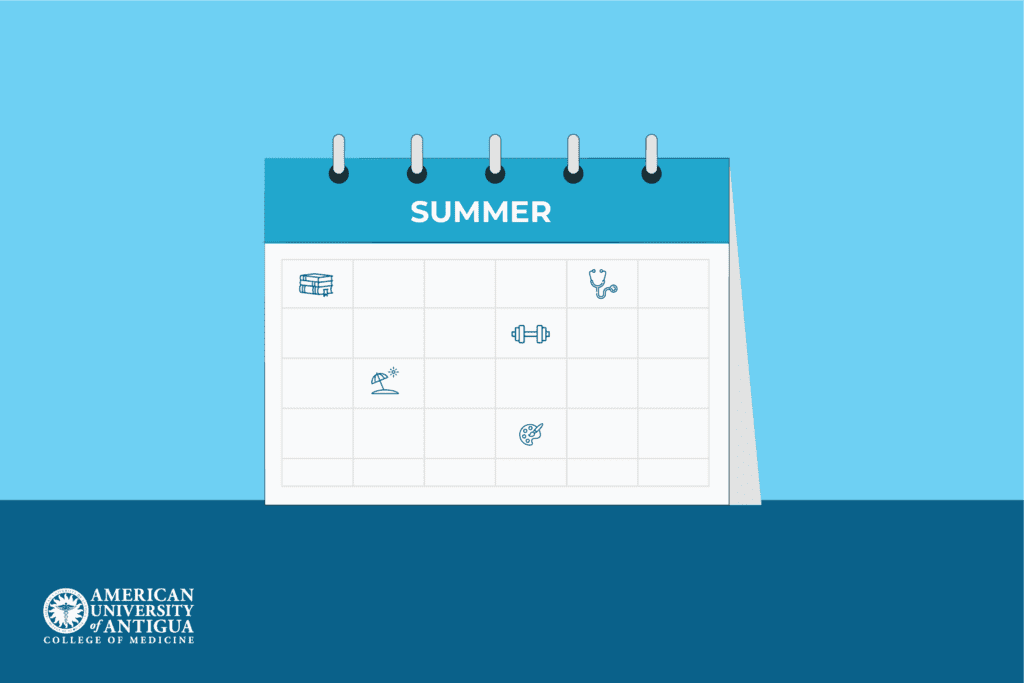Does Med School Have Summer Break? Tips for Students
Key Takeaways
- The length and schedule of summer break for medical students vary by year and program. Pre-clinical years have longer breaks, while clinical years have shorter breaks due to rotations.
- Volunteering, research, internships, and shadowing are all excellent ways to gain experience over the summer, which improves skills and residency applications.
- The balance between work and relaxation is crucial. Set objectives, make flexible plans, and take breaks to prevent burnout.
- Taking time for hobbies and travel helps you relax, recharge, and feel ready for school.
Medical school is known for its challenging workload, long hours, and constant pressure, which leads many to believe that students rarely get breaks. This common belief is especially shared by those aspiring to enter the field, who often wonder if they’ll ever have time off during their studies.
Unlike traditional undergraduate programs that typically include a long summer break, medical school schedules tend to be more varied and may not offer the same type of extended vacations. In this article, we’ll explore whether medical students have summer breaks and provide tips on how to make the most of this time.
✅ Request information on AUA's MD program TODAY!
Does Medical School Have Summer Break?

Yes, there are breaks during medical school, although they differ depending on the academic year and program. Pre-clinical students usually get a summer break, while some decide to use it for further study or training. During the clinical years, breaks are shorter and less frequent because of hospital rotations. In the sections that follow, we’ll examine how summer vacation differs for pre-clinical and clinical years of medical school.
Pre-clinical years
During the first one or two years of medical school, students usually get a summer break that lasts about 6 to 8 weeks. This break gives them time to rest, travel, or get ready for the next year of studies. During this time, some students volunteer, carry out research, or shadow medical professionals in hospitals.
Many medical schools now offer elective courses like research projects or global health opportunities that help students learn new skills and think about different potential careers. The break is an opportunity to unwind, but it can also be a fantastic time to develop and acquire worthwhile experience.
Clinical years
Due to clinical rotations, summer breaks during medical school’s clinical years are either significantly shorter or nonexistent. Students gain hands-on experience while spending most of their time working in hospitals and clinics through rotations, clerkships, and elective courses. Because these schedules are frequently very structured, students do not have the long breaks they did throughout their pre-clinical years.
However, there are usually short gaps between rotations that students can use to rest, travel, or study for exams. Some medical schools also let students choose lighter rotations or electives during certain times, giving them a little more flexibility to manage their time off.
What Do Medical Students Do During Summer Break?

The length of summer break varies depending on the country and university, as medical school schedules differ. During this time, students often engage in activities like research, clinical experience, exam preparation, or relaxation. Others may choose to focus on personal interests, charity work, or travel.
How students spend their break is typically determined by their academic goals, career aspirations, and what their school allows. We will examine each of these options in greater detail in the following sections.
Study for exams
Many medical students use their summer break to study for important exams like the USMLE Step 1. These exams are very important for getting into residency programs, so students take advantage of their free time to focus on studying without having to worry about attending classes.
Making the most of this time requires using effective study resources, such as question banks and review books, as well as developing a study strategy and setting daily objectives. You can also track your progress and pinpoint areas that need more focus by completing practice tests.
Gain experience through research and internships
Summer break is a great time for medical students to gain experience through research and internships, which can help make their residency applications stronger. Research is especially important because it showcases a dedication to learning and can help students stand out when applying for residencies. Likewise, internships provide hands-on experience and help students develop essential skills for their future careers.
Another great method to learn from seasoned professionals and explore other specializations is to shadow doctors during the summer. Last but not least, clinical internships give students the chance to work closely with patients, improving their skills and boosting their professional credibility.
Volunteer or join medical missions
Volunteering at hospitals or taking part in international medical missions throughout the summer is one of the best ways to obtain real-world experience and learn more about healthcare in a variety of contexts. These activities give students the chance to work closely with patients, learn about different medical procedures, and improve their clinical and communication skills.
AUAMED students regularly take part in programs such as community health outreach, where they help provide basic medical services to people without easy access to healthcare, or global health missions in developing countries. These experiences help students show their dedication to helping others, which can help them stand out when they apply for jobs or residencies, in addition to improving their medical knowledge.
Medical missions can also open up more career opportunities by allowing students to experience different healthcare settings and connect with professionals from various areas of medicine.
Take time off and travel
Summer vacations and travel are excellent ways for medical students to unwind and experience the world from a variety of perspectives. Learning about other cultures, health systems, and medical practices abroad may be a fun and educational experience for students.
Medical tourism sites, which allow students to observe healthcare in various contexts, and relaxing tropical islands are popular choices for medical students. Whether students are learning about healthcare in a new place or enjoying nature, traveling can help them return to their studies feeling refreshed and with a broader perspective.
Visit friends and family
Before the hectic clinical years begin, medical students should take advantage of the summer break to catch up with their loved ones. Spending time with loved ones can provide emotional support, help reduce stress, and remind students of how important it is to stay connected with people outside of school.
It’s critical to strike a balance between attending to other commitments, like studying or preparing for rotations, and spending time with the family. Students might arrange short vacations or weekend get-togethers with loved ones to balance relaxation with education. Reconnecting with family helps them return to school feeling refreshed and ready for the challenges ahead.
Build healthy habits
Medical students should take advantage of their summer vacation to form healthy habits that will help them succeed academically. It is crucial to prioritize self-care, exercise, and a healthy diet in order to reduce stress and maintain energy.
Engaging in regular physical activities, such as jogging, hiking, or going to the gym, can improve general health and focus. A balanced diet rich in fruits, vegetables, and protein helps boost their energy levels and improve their ability to focus.
Also, practicing mindfulness or meditation can support mental health and focus. By building these healthy habits during the summer, students will have a strong foundation to handle the challenges of medical school with a clear mind and healthy body.
Pursue hobbies
Engaging in hobbies during summer break is a great way for medical students to take care of their mental health and reduce stress. Having a hobby gives students a break from the hard work of medical school and helps them relax and recharge. Hobbies can also boost creativity, focus, and problem-solving skills, which are useful for studying and clinical work.
Some hobbies that med students enjoy include painting, cooking, hiking, and reading. Whether it’s something creative or active, pursuing hobbies helps students unwind and keep a balanced life, which is important for long-term success in medical school.
Explore your medical school location
If you’ve moved to a new place for medical school, it’s a great idea to take time to explore your surroundings. Getting to know local activities, attractions, and community events can help you feel more connected to your new home. Whether it’s visiting local parks or exploring historical sites, these activities provide a nice break and help you relax.
For example, students at the AUA medical school in Antigua can enjoy the beautiful sea, hiking trails, and the island’s lively culture. Exploring the area not only helps you unwind but also lets you appreciate the special things about your new location.
How to Make the Most of Your Med School Summer Break

To make the most of your med school summer break, it’s important to find a balance between being productive and taking time to relax. A good way to do this is by setting clear goals for what you want to achieve, whether it’s studying for exams, getting experience through internships, or focusing on your personal well-being.
Make a flexible plan that gives you time for both work and rest, as it’s important to stay busy without feeling overwhelmed. Focus on activities that support your health, like exercise, hobbies, and spending time with family and friends. Don’t forget that rest is key to avoiding burnout, so make sure to take time to relax.
Conclusion
Medical school summer breaks may differ in length, but they provide a chance to recharge and gain valuable experience. Whether students choose to study for exams, participate in internships, travel, or spend time with family, planning ahead helps ensure a productive and restful break. Balancing work and relaxation is key to avoiding burnout and staying motivated for the challenges ahead.
Want to learn more about medical education at AUA? Explore AUAMED and see what sets it apart.
Frequently Asked Questions (FAQs):
How much time off do you get in med school?
It depends on the school and year—pre-clinical students may get summer breaks, while clinical students have shorter breaks between rotations.
Do med students get weekends off?
Pre-clinical students usually have weekends free, but clinical students often work weekends during hospital rotations.
Which is the hardest year of medical school?
Many consider the second year the hardest due to intense coursework and Step 1 exam prep, while others find the first year or clinical rotations the most challenging.
✅ Request information on AUA's MD program TODAY!